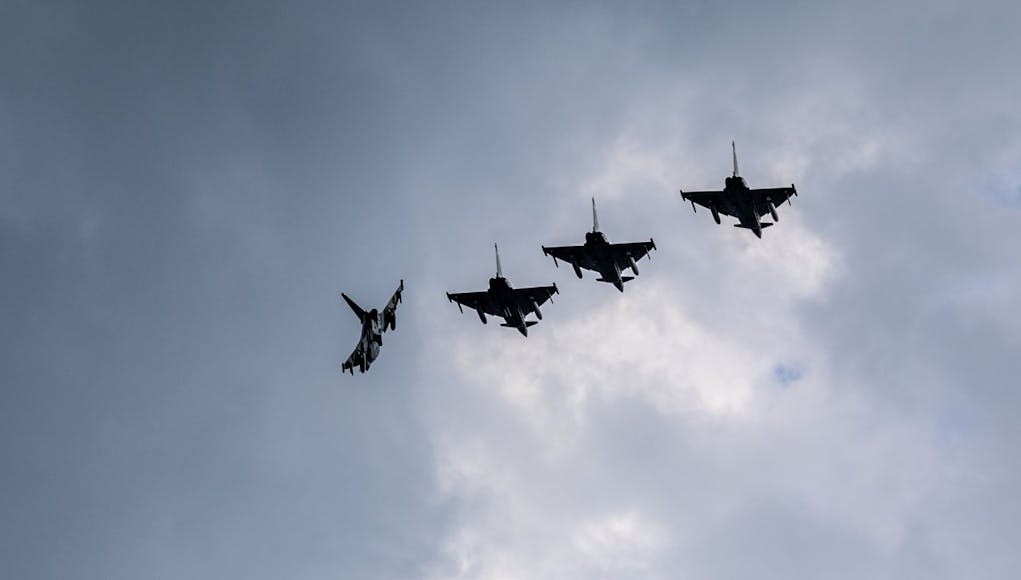UK fighter jets and helicopters have taken part in a notable multi-domain training exercise in Estonia, alongside 11 NATO allies.
This activity involved more than 10,000 personnel and was held throughout May.
Royal Air Force Typhoon fighter jets and Army Air Corps Apache helicopters completed their training exercise last Friday. The main focus was practising strikes on sea targets with heavy machine guns and advanced missiles.
This training took place off the Estonian coast, further emphasising the global reach and adaptability of the UK armed forces.
The exercise, dubbed “Spring Tempest”, was a joint operation with Estonia and France. It highlighted the capacity of the UK and its allies to deliver precise strikes deep into enemy territory.
“Exercise Spring Tempest has been an outstanding opportunity to integrate effects across the Land, Maritime and Air domains. Working with the Royal Navy and Army has allowed us to exercise high-end skill sets, while enhancing interoperability across a broad range of NATO allies,” said Wing Commander Scott MacColl, 140 Expeditionary Air Wing’s Commanding Officer.
The Army Air Corps Aviation Taskforce supplied the Apache helicopters, armed with Hellfire missiles, CRV7 rockets, and 30mm rounds. The RAF provided the Typhoon jets, from 140 Expeditionary Air Wing, equipped with Paveway IV laser-guided bombs and 27mm armour piercing rounds.
The combined exercise involved a Forward Air Controller operating from a nearby Wildcat helicopter. This support enabled both types of aircraft to refuel and rearm while still in the mission area.
These training exercises followed closely on the heels of “Exercise Spring Storm”, another significant military training event in Estonia. This previous event saw over 1,500 UK soldiers and more than 10,000 personnel from 11 NATO countries participate in the largest annual military exercise in Estonia, under the UK-led NATO enhanced Forward Presence.
MacColl further emphasised the value of the exercise in solidifying NATO alliance, stating, “The flexibility to operate effectively across differing environments demonstrates our key contribution to collective defence and regional security. As important, the scale of this exercise further develops Alliance cohesion and cross nation understanding.”














Here’s the plane the Ukraine were going to send, but a previous engagement got in the way
https://i.postimg.cc/WbLNtWsr/Untitled-1.jpg
And with 2 SS under the wings. 👍
The article is about NATOs precision strike capability and whilst Russia has a similar capability, from the information made available to the public sector backed by how far Russia has advanced into the Ukraine we can only arrive at the conclusion, that despite the many advantages Moscow held (and still does) over it smaller neighbour they have failed to capitalize on it. We see this in the many examples (some even caught on camera) of missiles and bombs failing to hit their target, we see it in the many instances of urban targets getting struck (But to be fair, that could be intentionally directed at West Liberals demanding a ceasefire on Moscow’s terms because in their eyes, NATO can only be to blame) and we see it in the poor (yes poor) progress they have made using the single most powerful military in Europe, with a military designed and built along the lines of rapid thrusts against the rear of its much weaker neighbour.
Yet it is the Ukraine and not Moscow which showing itself as the one carrying out pure tactical precision strikes , we saw this with their targeting of Berdyansk harbour last May (caught on film) where the Russian landing ship Saratov was sunk after getting hit by a OTR-21 Tochka, what makes this even more damning for Moscow, is the port had been targeted in the days before and they took no notice, well the video of the aftermath of the above strike certainly made them notice. In June the Ukrainians stuck an ammunition warehouse in Krasny Luch followed up in Jan of this year with that strike on Soledar ending in over 100 Russian deaths. In contrast Moscow using the same missile (most likely of a higher and newer standard than the ones used by Kyiv) have hit a hospital in Vuhledar, the railway station in Kramatorsk killing over 100 people.
We see similar with the use of Tupolev Tu-141 Strizh drones when in Dec 2022 a Ukrainian strike using such destroyed a couple of Tu-95s at Engels-2 airbase resulting in Moscow redeploying all its heavy bomber assets to smaller airbases further away from the Ukraine. We saw something similar in the Crimea when after the airbases there were struck, Moscow redeployed its strike aircraft based there to bases inside Russia.
Lets not leave out the use of waterborne UAVs against the Crimea bridge and against Russian ships in harbour.
All of the above were carried out by the use of Soviet era and Ukrainian built weaponry, which on paper should not be as capable (or as effective) as the ones in the Russian inventory but which the Ukrainians have used with the flair of a surgeon as opposed to the brute force of a Moscow Dynamo thug armed with a vodka bottle
Now Kyiv has received western precision strike weaponry such as the M270, HIMARS, which has forced Moscow to disperse and hide its assets (Something it should have been doing from day one) resulting in adding time and effort to Russian plan of actions, troop redeployments, the passage of information from HQs and of course replen.
Well the arrival of the Ground Launched Small Diameter Bomb and now the Storm Shadow (hopefully France will hand some over as well) will result in more constraints for the Russian military, seeing that all of occupied Ukraine is now well in reach of Kyiv and as we have seen these past few weeks, Russian military assets no longer have the luxury of distance to keep them safe.
Well written explanation of the situation, thank you Farouk.
Nice, and those little beauties under the wing are most certainly not zanussi washing machines as per the Russian Air Force bomb loads!!!!!!!